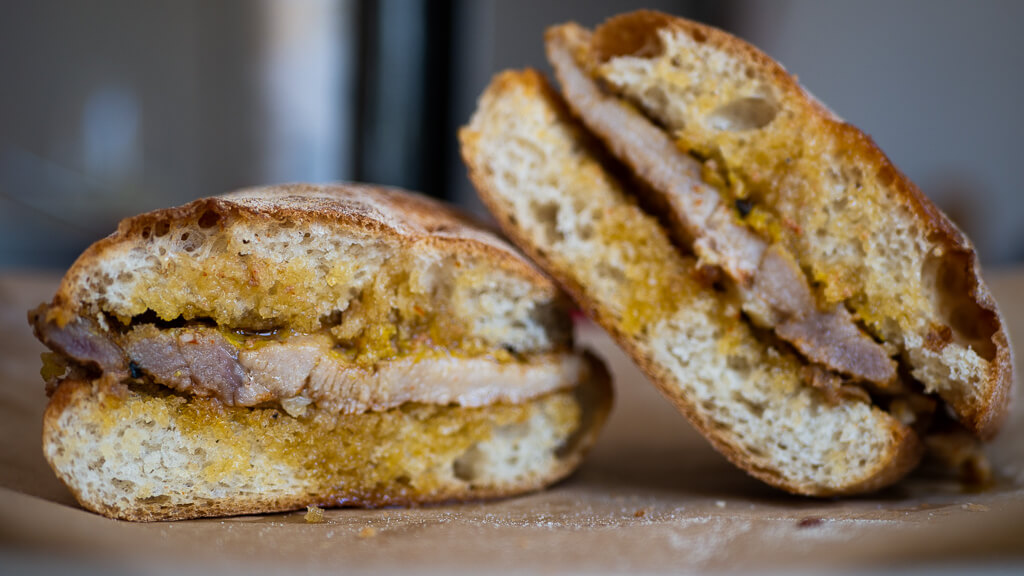The bifana is a traditional Portuguese sandwich that comprises of a bread roll filled with marinated pork cutlets. The secret is in the marinade and how its cooked. It’s deliciously Portuguese and simple, made from garlic, white wine, and a few spices. When it comes together you have a brilliant snack that can and should be eaten at all times of the day. They’ll be found in your cafés and snack bars and can be as cheap as €1.50! It’s traditionally served on a Papo Secos, a crusty but fluffy type of Portuguese bread.
Multiple cafés claim to be the original creators, and there are several different styles available. In the north of the country, they’ll add beer and passata to the sauce. While in the south they tend to stick to white wine. There’s differences in how the meat is prepared too. Some will keep it to a single tenderised pork cutlet, while others will cut the pork into small pieces or even shred it. Like many classics from Portuguese cuisine, there’s a lot of regional differences and pride invested in them. You’ll always find a heated debate, if you try to work out which is best. So to be precise, this Bifana recipe is the typical style you’ll find in the south of the country that originates in Vendas Novas.
Ingredients:
- 4 thin pork cutlets (approximately 300gr) – If you are in Portugal you can easily find specific pork cutlets for bifanas in a supermarket or your local butcher
For the Marinade
- 1tsp of sweet paprika
- 1/2 tsp red chilli flakes
- 3 crushed garlic cloves
- 2 bay leaves
- 200ml dry white wine
- salt and black pepper to taste
To Fry
- 2 tbsp lard
- 2 tbsp butter
- 1 tbsp olive oil
To Serve
- 4 white crusty bread rolls (if you are in Portugal ask for carcaças or papo-seco)
- Mustard, we prefer a strong English one


Preparation:
- Let’s start by tenderizing our pork cutlets. For that you can use a meat tenderizer or even a rolling pin to gently pound the pork cutlets one by one, both sides.
- Place the cutlets in a bowl. Season it with salt and pepper and then add the remaining marinade ingredients rubbing it into the meat. Make sure that everything is in contact with the pork. Cover the bowl with cling film and put it in the fridge for at least 4 hours or ideally overnight.
- Put a frying pan over medium heat and add the fat: lard, butter and olive oil. Once the mixture is hot, gently place in our pork meat, keeping the marinade aside. You may be thinking we are using too much fat but don’t worry, the idea here is to slowly ‘confit’ the pork instead of frying it like you would normally do with a steak.
- Once the oils start bubbling (about 5-8 minutes) flip the pork and add to the frying pan its marinade, including the garlic.
- Occasionally stir and flip the pork until the garlic cloves are cooked (it will become a puree when you squeeze it with a fork). Let the sauce reduce a little bit more.
- Meanwhile, cut open the bread and quickly toast it, we want it still soft inside.
- Now it’s time to put it all together. Glaze both sides of the bread with the juicy pork sauce then add a steak. Serve it with mustard, our favourite one is an English mustard.



Let us know in the comments if you’ve tried our Portuguese bifana recipe and what you think of it! If you’re hungry for more Portuguese sandwiches, we have some more recipes for a Prego no Pão and the mighty Francesinha!
If you like discovering Portuguese recipes, sharing your own, and commenting on your favorite Portuguese Food, Drinks & Recipes we’d love for you to join our Facebook group!
Sign up for our newsletter! One email each week, with just our latest articles and recipes, no spam!

These are the best bifanas I have tasted. My family and friends say they taste just as good, if not better, then the ones we have in Portugal. Thank you for the recipe.
Glad to hear it! We love making them for our guests and sharing a little bit of Portugal!
Annie
Great recipe! Easy and delish!! Reminds me of bifanas at Portuguese festivals.
That’s great to hear! Pre-pandemic we loved finding local bifanas at the smaller festivals around the Algarve!
Annie
Really great recipe and even better method/instructions. I’ve lived in Portugal now for 2 years (after lots of visits) and found many bifanas dry and kind of bland. This recipe brings the juciness and the flavor!
On our second round we doubled the paprika (sweet smoked) and sauteed some onions, too. Maravilhoso! My Portuguese friends – who are serious traditionalists – devoured them!
We’re making them for guests in a couple days. I can’t wait!
Ahh yes, nothing worse than a dry bread roll, or a lack of seasoning! Our Portuguese friends are always surprised that we mastered the bifana and now they use our recipe too!
Annie
My great Grandparents came to the United States from St. Michael in the Azores in 1877, I was born in 1943 so pretty soon I will have been enjoying these slices of heaven for almost 80 years. Still my favorite sandwich (but I like to put a big slice of pickled hot red pepper on them).
May I know if you meant each piece of cutlet weighs about 300g? Or total 4 pieces with total 300g?
Each cutlet should be around 75-100g, sliced thinly!
Hi Annie!
Could you please specify which part of the pork is used for the cutlets?
Thank you!
G
Yes, pork cutlets from the leg or loin!